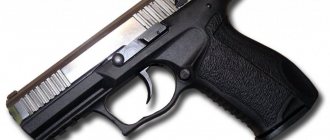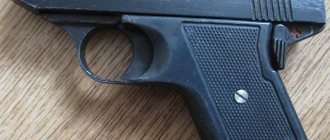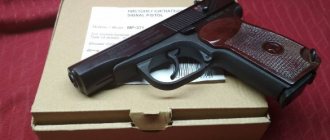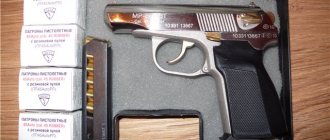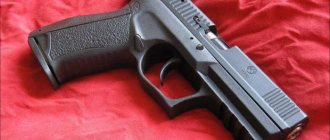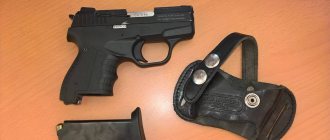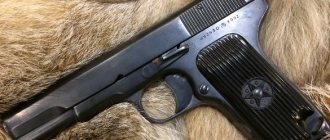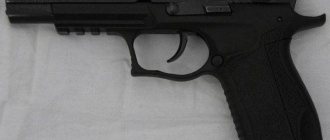Despite the fact that now any firearm of limited destruction (LLD) must be domestically produced to comply with the Law on Weapons, weapons from foreign manufacturers are still present on the market. This includes traumatic weapons imported into Russia before the amendments came into force on July 1, 2011, and even modern models that are converted into LLCs from sports and gas weapons or contain a number of non-main parts of foreign production. Purely domestic “traumatic” models include a fairly large number of pistols and barrelless weapons. They are distinguished mainly by price. For example, the cheapest OOOP pistol on the Russian market is the MP-79-9T (“Makarych”) in 9 mm RA caliber. For the sake of objectivity, it is worth saying that the mass arming of the population with traumatic weapons began with “Makarych” at the end of 2004. This model is not outdated even now, but only when using cartridges with muzzle energy up to 60-70 J.
MR-79-9T (“Makarych”) 9 mm RA
The use of more powerful (80-91 J) cartridges can cause failure of the weakest part of the pistol - a thin-walled barrel with depressed protrusions (“teeth”). The most popular now is the 80th model (MP-80-13T) chambered for .45 Rubber. This pistol (if you do not use it in a shooting range as a training pistol) has a long service life, but the weak penetration ability of the 13 mm bullet of its cartridge makes it a less suitable weapon for self-defense compared to the 9 mm RA. It is very rare to find on sale an MP-353, externally made to look like a Yarygin pistol (YA), but its high price, large dimensions, a number of design flaws and the .45 Rubber cartridge make it not the most successful pistol for self-defense.
MP-80-13T "Makarych" .45 Rubber
This model is not outdated even now, but only when using cartridges with muzzle energy up to 60-70 J. The use of more powerful (80-91 J) cartridges can cause failure of the weakest part of the pistol - a thin-walled barrel with depressed protrusions (“ teeth"). The most popular now is the 80th model (MP-80-13T) chambered for .45 Rubber. This pistol (if you do not use it in a shooting range as a training pistol) has a long service life, but the weak penetration ability of the 13 mm bullet of its cartridge makes it a less suitable weapon for self-defense compared to the 9 mm RA. It is very rare to find on sale an MP-353, externally made to look like a Yarygin pistol (YA), but its high price, large dimensions, a number of design flaws and the .45 Rubber cartridge make it not the most successful pistol for self-defense.
Types of traumatic weapons
The injuries protected no lives. Most are prototypes of military, firearms, converted into trauma or pneumatic weapons. Traumatic devices are more popular because they do not require the installation of gas cylinders, but look like live ammunition.
Main characteristics of traumatic weapons:
- Compact and lightweight for easy carrying.
- High safety for the shooter and simple controls.
- Self-defense, but not seriously harming a person.
There are many variations of traumatism. Some are more powerful and better suited for self-defense tasks than others. They vary in caliber, shape, size, functionality and internal mechanism. Some injuries are made using steel parts, while others have a high-quality plastic base. Most types of traumatic weapons are prototypes of firearms. There are so many variations of “Tula Tokarev”, “Makarov”, “Stechkin”, etc.
There are many examples of traumatism. The first weapon of this design appeared in Russia in the last century. The PB-4 OSA pistol became an officially traumatic product for self-defense in 1999. It was then that government authorities issued a certificate for this weapon. Already in 2004, a sample of ammunition for a gas gun was certified. The rubber bullet was intended for the Makarov prototype - IZH-79-9T. Only in 2011, a law was passed stating that traumatic guns will now be classified as limited-destruction firearms, abbreviated as OOOP.
Already in 2013, about 730,000 individual units of traumatic pistols received official certificates. By 2022, this figure has increased to 950 thousand. Civilian weapons include pistols, revolvers and any shooting devices. To find out which types are recognized by law, you should consider the classifications of traumatic products:
- OOOP devices include models such as the MP-79-9TM pistol.
- Service version of the OOOP with traumatic action cartridges (MR-471, PST “Kapral”, RS, Jorge S, Jorge-1S.
- The barrelless (illegal) version includes: PB-4 OSA, PB-2 “Aegis”, MR-461 “Guardian”, “Cordon”, MMRT-2 “Gadfly”, MMRT-3 “Hornet-2”, “Shaman” , VPO-501 “Leader”.
The last category also includes gas pistols and revolvers such as: Safegom, IZH-78-9T, Kimar mod.85 Auto, MP-341 “Hauda”, Stalker, TKB-0216T “Agent”, PM-T, MP-355, etc. .d. To date, not all trauma patients in Russia have received certificates from the OOOP category. List of traumatic weapons that can be purchased by law:
- WASP R;
- MP-78-9T;
- MP-79-9T;
- MP-353;
- Streamer 1014;
- "Jorge";
- Shark;
- Scrap – 13;
- Grand Power T10, T12;
- Warrior 410;
- PM-T.
Legal varieties of traumatic weapons include all modifications of the above pistols, as well as devices under the “Groza” logo.
Pistol MP-353 caliber 9 mm RA
The Osa series barrelless pistols chambered for electric ignition cartridges have an even lower price. Until 2011, when the Osa cartridge bullets had a metal core, it was a completely self-sufficient self-defense weapon. However, with the legislative limitation of the muzzle energy of “trauma” to 91 J and the ban on bullets with a metal core, this weapon was attractive only in terms of price.
Kalashnikov assault rifle - watered down version
If you look into gun shops or online stores that sell all types of weapons, you can see a Kalashnikov assault rifle for sale. In fact, this is a watered-down version, which is a noise device. Visually, it follows the shape of the Kalash, because it is based on the drawings of the combat version. This AK is completely different from a real machine gun if you consider its technical characteristics and functionality. Basic moments:
- Firing with blank cartridges. Bullet speed - 130 m/sec.
- Application: training, sports games.
- Made from metal and wood.
- Purpose: targeted shooting at a distance of up to 20 meters.
- The average price is 7000-13000 rubles.
Converting devices to the “auto-fire” function is prohibited by law, so a real Kalash-trauma will not exist in nature (at least, the official licensed version). For those who still want to have a cold machine gun in their arsenal, you can play sports with it in the following areas: airsoft, hardball. If you purchase the traumatic variation, the store will have up to 300 ammunition. If it is pneumatic, then one gas cylinder will be enough for 100 shots.
It is important to understand that traumatism was created so that a person can protect himself in a difficult situation. Burst shooting is a combat option for attacking the enemy and will never be classified as a traumatic weapon. Among analogues, it is worth paying attention to the Saiga carbine, which is similar to an AK, only without the ability to fire in bursts. Also worthy of attention is the traumatic version of the Esaul submachine gun, which is deprived of burst fire.
Pistol Vostok 9 mm RA
The design is based on the Ukrainian “Fort”, but Vostok is entirely manufactured in Klimovsk. The pistol is made of very high quality, which is reflected in its price. However, due to the outdated design of the barrel, the muzzle energy of Vostok pistols, the legal limit of 91 J, is not achieved with any of the 9 mm RA cartridges produced today. Vyatsko-Polyansky still offers “Leader” pistols, converted from TT combat pistols into barrelless firearms. The 11.43x32T cartridge and the general quality of the “fenced” TT work against this model - the “Leaders” defect rate is the highest on the market.
Traumatic AK - does it exist?
The Kalashnikov assault rifle belongs to the category of serious military products. Even if some designer thought about making a traumatic version of the AK, strictly following the drawings and design features, he quickly abandoned these thoughts. Neither the dimensions, nor the intensity and force of the shot make it possible to cause such an injury. Despite this, Kalashnikovs are constantly being modernized, drawings are copied and internal features are included in new models of self-defense devices.
According to statistics, 1/5 of all small arms, automatic and traumatic weapons available in the world borrowed internal mechanisms or the principle of operation of products from AK. Therefore, in order to obtain a traumatic version of Kalashnikov, it is necessary to cool the combat barrels, which entails a number of risks and unpleasant moments. The main arguments that suggest that a traumatic AK loses the very essence of the concept of “machine gun”:
- An assault rifle can fire in bursts when such functionality is prohibited by law for a traumatic weapon.
- Almost all modern weapons are automatic, but in order for a weapon to become an automatic weapon, the device and design of the barrel cannot be altered, and this is the first thing that needs to be modernized in order to reduce the muzzle force and downgrade the class of the weapon.
- According to the law, a traumatic magazine should not contain more than 10 rounds of ammunition, which is significantly less than what a Kalashnikov can afford.
Frequently asked questions to help you understand whether traumatic AK exists.
Question to the expert
What devices are classified as traumatic weapons?
Machine guns, pistols, submachine guns. They are created by cooling.
What is an automatic machine?
Machine guns are types of firearms designed to defeat an enemy in close combat. Their distinctive feature is the ability to create a high density of fire.
What does the law say about converting firearms into traumatic weapons?
According to the law, the possibility of firing in bursts must be excluded if it is provided for in the combat version.
Difference between automatic and semi-automatic devices?
Regardless of the type of weapon, it can be automatic or semi-automatic. It all depends on the design decision. The concept of “automatic” is a feature of cocking the hammer, but not the auto-fire mode.
Why can’t designers make a prototype of a Kalash, but only a traumatic one?
This is real and the AK-traumat device exists, but it fires blank ammunition and cannot become a self-defense tool. Only in terms of the intimidating element.
Theoretically, a Kalashnikov can become an injury, but from the original AK only external similarity will remain, but not functionality, combat strength or the progressive order of shots.
Pistol Leader TT
The TTK-F pistol is produced on the basis of TT in Russia. This is a shortened version of the TT pistol due to the barrel and bolt casing. All main parts of the pistol (frame, barrel and slide) were made from scratch. The remaining components and parts (trigger assembly, magazine, firing pin, springs, ejector and magazine) are taken from the spare parts for the TT pistol. Due to the width of the magazine, the pistol uses a 10x32T cartridge. Taking into account the very low cost of this spare parts and accessories, the pricing of the TTK-F is not clear, the cost of which is comparable to models containing foreign-made parts and assemblies.
In general, the TTK-F turned out to be a very good pistol (despite the lack of self-cocking in the trigger), if not for the very weak 10x32T cartridge and the high price for which you can buy a more powerful pistol, converted in Russia from foreign-made weapons or their parts, under cartridge 9 mm RA. Therefore, if you choose “with your wallet”, then with a smaller resource (relative to steel structures) and a price similar to domestic pistols, but with more “spirited” power characteristics, it is better to opt for self-defense weapons made of alloys.
In addition to better ergonomics and greater compactness, these models are more reliable. If you opt for pistols made of steel, then, of course, at a higher cost, they are just as much more suitable for self-defense. Both in terms of ergonomics and power, and in terms of resource. However, we should not forget that even a Leader pistol in the skillful hands of a trained shooter will be much more effective than the most expensive traumatic pistol in the hands of an untrained shooter. True, the same trained shooter with a higher-quality traumatic pistol will be able to repel an attack even faster and better.
How to choose the right traumatic gun?
Before purchasing a traumatic pistol, you should decide on the purpose of the purchase. Someone is looking for an option that can be carried discreetly. For some it is important to have a copy of a certain model of military weapon. For the third, the power of this weapon is important. Having decided on the purpose of purchasing a weapon, you can already consider the selection criteria.
The caliber of the weapon is one of the main criteria where you should start choosing. With a larger caliber, the gun will have more power, but also be larger. Although, it should be noted that in self-defense, even a small pistol can cause damage to the enemy.
Please note what types of cartridges are suitable for your model of traumatic pistol. Not all manufactured rubber bullets are suitable for every type of pistol. Particular attention should be paid to the allowed kinetic energy of the bullet. If you use bullets whose energy exceeds the permissible norm, you can easily disable the weapon.
The material used to make the weapon plays an important role when choosing a model. Weapons made from soft materials can become unusable at any time. This can happen both during the shot and before it.
Each weapon is designed to fire a certain number of shots. Since traumatic guns are not made from such durable materials as military weapons, it is not advisable to learn to shoot with them. And if you do not have experience in handling weapons, and training is necessary, then preference should be given to a model with a large number of shots.
When choosing between a foreign and domestic manufacturer, do not rush to vote in honor of the first option. Russian arms manufacturers are no worse. In addition, they manufacture weapon models in accordance with current legislation.
The size of the gun should also be taken into account. In self-defense, the main criterion is speed. A small pistol will be convenient to always have with you. And in order to quickly use it in the event of an attack, you will need a comfortable holster. A large pistol will be noticeable, and not always comfortable for constant wear.

